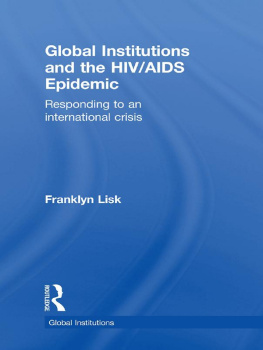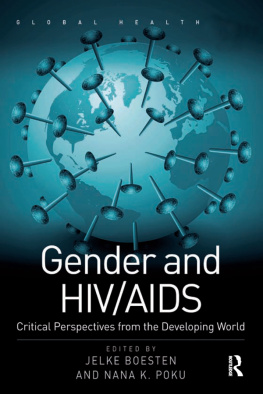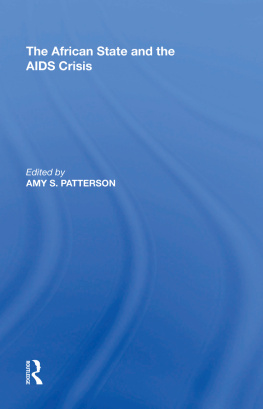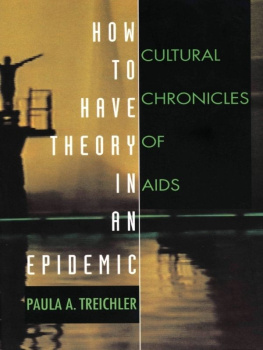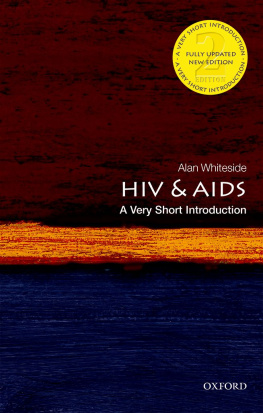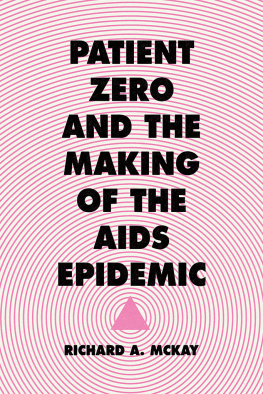Infectious diseases had been declining for many years in the United States when an apparently new infectious disease, acquired immune deficiency syndrome, or AIDS, suddenly appeared in the early 1980s. This is the most serious disease to appear in modern times, and as of this writing, neither vaccine nor cure is in sight. From a sociological point of view, AIDS is perhaps the most important disease in American history, and it is certainly one of the most important in all history.
Although most scientific experts on AIDS agree that a virus called human immunodeficiency virus (HIV) is the basic cause of AIDS, social factors are significant in the extent to which and the way in which the virus is transmitted. Some populations with certain social and cultural characteristics have much higher rates of HIV-AIDS. To date in the United States, HIV-AIDS has been predominantly a male disease and is disproportionately concentrated among male homosexuals (gays), injecting drug users (IDUs), and some racial-ethnic groups. A virus obviously does not discriminate against people because of their sexual orientation, drug use, or skin pigmentation. Rather, social and cultural factors explain why HIV-AIDS has become so prevalent in these populations. They also explain why HIV-AIDS in sub-Saharan Africa is far more prevalent than in the United States and why it is about evenly distributed between males and females in Africa. Furthermore, that the epidemic has slowed in the United States in recent years but not in sub-Saharan Africa (and other developing regions) also points to the role of social and cultural factors in the transmission of HIV.
Sociologically, one of the most significant aspects of any disease is its social meaning as distinct from its medical meaning and how the former affects the way some people react to those who have the disease. The social meaning of and societal reactions to HIV-AIDS have been unusually negative and extreme. Ostracismthe sociologists favorite topichas been common; persons who have HIV-AIDS have not always been treated as persons with a medical pathology but rather as moral deviants and outcasts. Although experts agree that education and prevention programs would slow the spread of HIV in the United States, the social meaning of the disease leads some people to oppose those very programs. At the same time, others have charged the government with refusing to support research and prevention programs because government officials do not care about the plight of the populations in which HIV-AIDS is most prevalent. Some gays and African Americans have even claimed that HIV-AIDS is a genocidal plot against them. Such extreme reactions are simply not in keeping with the way a civil society based on humane and rational values typically reacts to disease.
These and other social aspects of AIDS have been topics of myriad news columns, television programs, technical reports, books, and journal articles since the mid-1980s; the social aspects of HIV-AIDS have been analyzed more in this short time period than have the social aspects of any other disease in history. Recently, however, concern about AIDS has begun to decline. The viral cause of AIDS is now known, the major types of high-risk behaviors have been identified, the rate of increase of new AIDS cases is slowing (at least in the United States), the ostracism of people with AIDS has become milder in tone, and the demonstrations and accusations by AIDS activists have been muted. Hence, New York Times reporter Jeffrey Schmalz, who died from AIDS, wrote in a posthumously published New York Times Magazine article (Whatever Happened to AIDS?, November 28, 1993) that AIDS was old news and that interest had waned. The social crisis of AIDS had been analyzed and reanalyzed; there seemed to be little new to say.
Why, then, in the mid-1990s, publish a book on social aspects of AIDS? Such a book is needed because this disease is still not very well understood sociologically. Despite all the attention that social factors in the etiology of AIDS and the societal reactions to the AIDS epidemic have received, their study in terms of the concepts and principles of sociology has been extremely limited. True, scientific experts agree that to attribute the cause of AIDS to a particular virus, while medically valid, oversimplifies and ignores the fact that certain behaviors associated with particular groups and populations are major factors in the etiology of AIDS. But such behaviors are anchored in the cultural norms and social institutions of those groups and populations. High-risk behaviors for transmitting HIV have not been examined extensively from this perspective.
Societal reactions to the AIDS epidemic are also anchored in cultural beliefs and social institutions. Modern society is indeed more civil than its predecessors, but the social forces typical of past societies are latent in the structure of todays society. When an epidemic like AIDS appears, such forces emerge and lead people to act as their ancestors did to previous epidemics. No less than the etiology of HIV-AIDS, the societal reactions to the AIDS epidemic pose important social problems that are as vexing as are the medical aspects of the disease.
By examining the two major social dimensions of HIV-AIDSits social etiology and societal reactions to the diseasewith concepts and principles of sociology, I show how HIV-AIDS is more complex and socially embedded than many have assumed. Although I bring little original evidence to bear on the epidemic (experts on HIV-AIDS and much of the public are aware of most of the basic facts about the disease), I hope that by interpreting these facts in terms of sociological concepts and principles, I can shed a different light on HIV-AIDS. The insights that such an interpretation brings can provide a broader understanding of HIV-AIDS and the course the epidemic has taken. Perhaps these insights will also help clinicians, public health officials, policymakers, and AIDS activists in dealing with the problems of this terrible disease.





